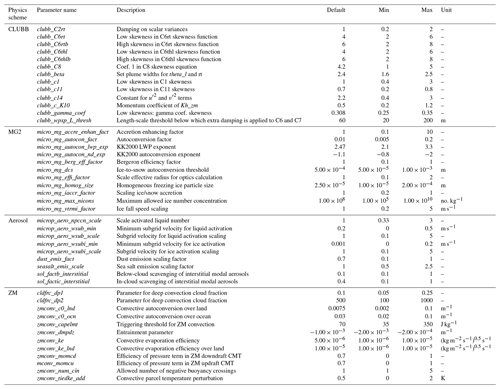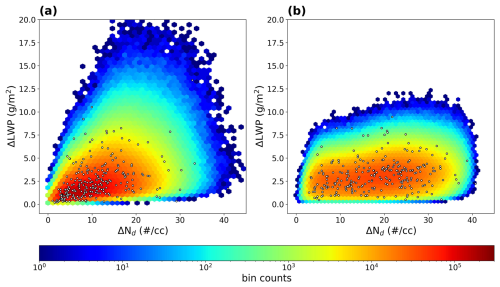the Creative Commons Attribution 4.0 License.
the Creative Commons Attribution 4.0 License.
Constraining aerosol–cloud adjustments by uniting surface observations with a perturbed parameter ensemble
Daniel T. McCoy
Trude Eidhammer
Andrew Gettelman
Ci Song
Hamish Gordon
Isabel L. McCoy
Aerosol–cloud interactions (ACIs) are the largest source of uncertainty in inferring the magnitude of future warming consistent with the observational record. The effective radiative forcing due to ACI (ERFaci) is dominated by liquid clouds and is composed of two terms: the change in cloud albedo due to redistributing liquid over a larger number of cloud droplets (Nd) and the change in cloud macrophysical properties due to changes in cloud microphysics. These terms are, respectively, referred to as the radiative forcing due to ACI (RFaci) and aerosol–cloud adjustments. While the magnitude of RFaci is uncertain, its sign is confidently negative and results in a cooling in the historical record. In contrast, the adjustment of cloud liquid water path (LWP) to enhanced Nd and associated radiative forcing is uncertain in sign. Increased LWP in response to increased Nd is consistent with precipitation suppression, while decreased LWP in response to increased Nd is consistent with enhanced evaporation from cloud top. Observational constraints of these processes are poor in part because of causal ambiguity in the relationship between Nd and LWP. To better understand this relationship, precipitation (P), Nd, and LWP surface observations from the Eastern North Atlantic (ENA) atmospheric observatory are combined with the output from a perturbed parameter ensemble (PPE) hosted in the Community Atmosphere Model version 6 (CAM6). This allows for causal interpretation of observed covariability. Observations of precipitation and cloud from ENA constrain the range of possible LWP aerosol–cloud adjustments relative to the prior from the PPE by 15 %, resulting in a global value that is confidently positive (a historical cooling) ranging from 2.1 to 6.9 g m−2. It is found that observed covariability between Nd and LWP is dominated by coalescence scavenging and that this observed covariability is not strongly related to aerosol–cloud adjustments.
- Article
(9879 KB) - Full-text XML
- BibTeX
- EndNote
Atmospheric aerosols affect the global radiation budget through direct interactions with radiation and indirect interactions via clouds. Aerosol–cloud interactions (ACIs) are facilitated by aerosols serving as surfaces for water vapor to condense onto, forming cloud droplets. These aerosols are called cloud condensation nuclei (CCNs) and are essential for forming clouds in the troposphere (Gordon et al., 2023; Mason, 1960; Wilson, 1900).
While many CCNs have natural sources, such as dust and sea spray (e.g., Carslaw et al., 2013), there are also CCNs emitted from anthropogenic activities, including increased emission of carbonaceous aerosols (Hamilton et al., 2018) and sulfur dioxide (Charlson et al., 1992). Changing the number of CCNs in a cloud can change the droplet number concentration (Nd) of the cloud, shifting the cloud's albedo (Twomey, 1974). This is referred to as the radiative forcing from ACI (RFaci, following notation from Bellouin et al., 2020). By affecting cloud and precipitation processes, changes in Nd driven by CCNs can also change macrophysical cloud properties such as cloud fraction (CF) and cloud liquid water path (LWP) (Ackerman et al., 2004; Albrecht, 1989). Changes in cloud macrophysics driven by changes in cloud microphysics in response to anthropogenic aerosols are referred to as aerosol–cloud adjustments. The sum of RFaci and forcing due to aerosol–cloud adjustments is termed the effective radiative forcing due to ACI (ERFaci). This paper focuses specifically on adjustments to LWP, although these are not unrelated to adjustments in CF.
Overall, there is high confidence that anthropogenic aerosols led to cooling during the historical record (Bellouin et al., 2020). Aerosol cooling since the Industrial Revolution has offset warming from anthropogenic greenhouse gas emissions (Andreae et al., 2005; Charlson et al., 1992), but the degree to which warming has been offset is uncertain. Because of this gap in our knowledge, it is difficult to know the true sensitivity of Earth's surface temperature to greenhouse gas emissions (Forster, 2016; Watson-Parris and Smith, 2022). Aerosol cooling is dominated by ERFaci (Bellouin et al., 2020). Uncertainty in RFaci and aerosol–cloud adjustments both contribute to uncertainty in ERFaci. Uncertainty in the radiative forcing due to aerosol–cloud adjustments based on observations and global modeling outpaces uncertainty driven by RFaci (Bellouin et al., 2020; Gryspeerdt et al., 2020; Heyn et al., 2017). The range of predicted future climate consistent with the historical record motivates developing constraints on ERFaci and in particular the sign and amplitude of the large aerosol–cloud adjustments forcing term (Andreae et al., 2005; Watson-Parris and Smith, 2022).
There are several factors that contribute to the uncertainty in RFaci and aerosol–cloud adjustments. While the basic understanding of what processes set ACI and aerosol–cloud adjustments is good (Ackerman et al., 2004; Albrecht, 1989; Bretherton et al., 2007; Khairoutdinov and Kogan, 2000; Mülmenstädt and Feingold, 2018; Wood, 2012), these processes operate at small spatial and temporal scales that cannot be resolved by the global models that we rely on to calculate forcing. This scale of the mismatch means that we must parameterize these processes in global climate models (GCMs). This results in parametric uncertainty related to how a given process is parameterized (Regayre et al., 2018). It also results in structural uncertainty related to which processes are parameterized and represented in a given GCM (Regayre et al., 2023). In addition to uncertainty related to how microscale aerosol, cloud, and precipitation processes translate to the global scale, our ability to constrain ERFaci is hindered by our lack of knowledge regarding the pre-industrial (PI) baseline. We lack observations of PI aerosol spatial distribution, emission, and composition outside of a few regions (Hamilton et al., 2014) that maintain a pristine state in the present day (PD). This lack of observational constraint of the baseline PI atmosphere drives substantial uncertainty in forcing due to ACI (Carslaw et al., 2013; McCoy et al., 2020b).
To narrow uncertainty in ERFaci, we need to confront the GCMs that we rely on for calculations of ERFaci with observations of aerosol, clouds, and precipitation to identify whether there are parameter combinations that agree with observations and if our GCMs are structurally deficient (Ghan et al., 2016; Mülmenstädt and Feingold, 2018). A broad issue is that the causality linking aerosol, clouds, and precipitation is complex (Fons et al., 2023; Gryspeerdt et al., 2019; McCoy et al., 2020a; Stevens and Feingold, 2009). We provide a schematic illustration of some of the causal linkages in this aerosol–cloud–precipitation system in Fig. 1. Coalescence scavenging of aerosol and cloud droplets further confounds the relationship linking the cloud droplet number to liquid cloud properties (i.e., through aerosol–cloud adjustments that can increase and decrease LWP). Apart from in very specific situations (Christensen et al., 2022), we cannot untangle this causality using observations alone. In this study, we unite a model where causality can be explicitly determined with observations of clouds and precipitation where we must infer causality.
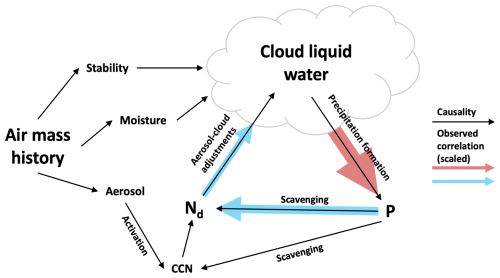
Figure 1A schematic describing the causal links on aerosol–cloud adjustments. The blue or red shading indicates a positive or negative correlation between the two variables at ENA, and the size of the shaded arrow indicates the relative magnitude of the correlation at ENA. These data are further detailed in Fig. 7.
We examine the adjustment of cloud LWP to changes in Nd. When evaluating how increased aerosol affects cloud liquid water content via Nd, there are two main effects of changes on Nd theorized to play a substantial role in setting ERFaci (Mülmenstädt and Feingold, 2018). The first is precipitation suppression, wherein the decrease in average droplet size from increased Nd reduces the precipitation production of a cloud, increasing the cloud's LWP (Albrecht, 1989). The second process is size-dependent evaporation and entrainment, wherein the increased Nd may increase entrainment or evaporation at the cloud top, reducing cloud liquid water content (Bretherton et al., 2007; Hill et al., 2009; Wang and Albrecht, 1994; Wang et al., 2003; Xue and Feingold, 2006).
Previous observations characterizing the sensitivity of LWP to Nd have shown a positive correlation between Nd and LWP in low-Nd clouds and a negative correlation in high-Nd clouds, with an average negative sign in oceanic cloud (Fons et al., 2023; Glassmeier et al., 2021; Gryspeerdt et al., 2019). However, it is challenging to understand cloud susceptibility to Nd based on observations without accounting for precipitation. Coalescence scavenging (via precipitation) is a strong controller of Nd in marine low clouds (Kang et al., 2022; Wood et al., 2012), and CCNs below the cloud may be removed by wet scavenging of aerosol (Textor et al., 2006). These relationships and the observed correlations between clouds and precipitation from observations from the Eastern North Atlantic (ENA) (Wood et al., 2015) atmospheric observatory, our surface observation source, are shown for reference (Fig. 1).
While there have been many studies inferring cloud adjustments from LWP sensitivity to Nd observed by satellites (Amiri-Farahani et al., 2017; Christensen et al., 2017; Fons et al., 2023; Gryspeerdt et al., 2017, 2019; Lebsock et al., 2008; McCoy et al., 2020a), there are comparatively fewer studies of aerosol adjustments from a surface perspective (Chiu et al., 2021; Feingold et al., 2003; Gettelman et al., 2020; McComiskey and Feingold, 2012; Wu et al., 2020). There are benefits and drawbacks to the use of surface observations. An obvious drawback to using surface observations is that they only provide a limited sampling of the atmosphere relative to a satellite. Another drawback related to sampling is that it is unclear how surface measurements scale to a GCM grid cell (McComiskey et al., 2009; Mülmenstädt and Feingold, 2018). However, surface observations have several benefits in terms of observing clouds and precipitation. Commonly used satellite Nd products have sparse airborne validation and potentially large systematic uncertainties in some cloud regimes (Ahn et al., 2018; Grosvenor et al., 2018; Gryspeerdt et al., 2022; Kang et al., 2021; McCoy et al., 2018). One source of uncertainty in satellite Nd is a lack of homogeneity in the satellite footprint (Grosvenor and Wood, 2014). Surface remote sensing has a substantially smaller footprint (McComiskey et al., 2009), which reduces the uncertainty inherent in passive retrieval-based calculations of Nd (Cho et al., 2015; Grosvenor et al., 2018; Nakajima and King, 1990). Aircraft observations of Nd are in reasonable agreement with spaceborne estimates in homogeneous cloud, but the agreement degrades in more heterogeneous cloud (Gryspeerdt et al., 2022). The sensor footprint of surface-based remote sensing of Nd is drastically smaller and aircraft evaluation suggests minimal impacts from changes in cloud heterogeneity (Zhang et al., 2023). Precipitation is challenging to observe from space (Kidd and Huffman, 2011; Pradhan et al., 2022; Sun et al., 2018). The ability to directly observe the precipitation flux at the surface is uniquely advantageous, although surface precipitation-observing instruments still struggle with observing very light precipitation and cannot observe virga. There are also benefits in surface observations of LWP; the retrieval used in this work (detailed in Sect. 2.1.1) utilizes an ensemble of instruments to observe LWP, allowing for higher confidence than a large-footprint passive microwave radiometer.
Here, we constrain aerosol–cloud adjustments based on observable properties sampled at ENA: cloud and precipitation state variables and their covariances. A perturbed parameter ensemble (PPE) hosted in a GCM is used to define the causal inference from observations. Surface observations are used to provide a constraint on global-mean aerosol–cloud adjustments in LWP. Section 2 describes observational data and the PPE used. Section 3.1 describes the framework used in this study to provide causal inference from observed cloud and precipitation. Section 3.2 constrains the PPE using observations. Section 3.3 provides a constraint on global-mean aerosol–cloud adjustments. Section 4 discusses the results and provides suggestions for future studies. Section 5 summarizes the conclusions.
2.1 Observations
We leverage surface remote sensing and in situ observations from the Atmospheric Radiation Measurement (ARM) Eastern North Atlantic (ENA) observatory (Wood et al., 2015). ENA is located in the northeastern Atlantic Ocean approximately 1000 miles (∼ 1600 km) west of Portugal on Graciosa Island in the Açores.
Use of surface-based observations and the selection of ENA are motivated by logistical and scientific concerns. Surface observations provide a unique set of strengths that align with the framework for constraining aerosol–cloud adjustment strength as described above. Our underlying constraint framework is not dependent on the source of observations of LWP, P, and Nd. However, we argue that surface observations are better suited for this problem than spaceborne remote sensing despite the much larger data volume and coverage afforded by spaceborne remote sensing.
ENA is one of three surface sites administered by ARM where observations of LWP, Nd, and P are available. The other locations are the ARM southern Great Plains (SGP) site centered near Lamont, Oklahoma, and the Layered Atlantic Smoke Interactions with Clouds (LASIC) field campaign that took place on Ascension Island in the central Atlantic. Maritime liquid clouds are a significant contributor to the uncertainty surrounding ERFaci (Bellouin et al., 2020; Carslaw et al., 2013; McCoy et al., 2017; Wall et al., 2022, 2023), and we argue that a marine environment provides more information about the cloud and precipitation processes driving global aerosol–cloud adjustments. This suggests that SGP is less relevant to our current analysis. Between ENA and LASIC, ENA has a significantly larger pool of observations due to its considerably longer observational period, with LASIC only providing 2 years of data compared to ENA's 9 (at the time of writing). Further, LASIC observes layers of carbonaceous aerosols in the free troposphere from southern Africa, the largest biomass-burning region in the world (Zuidema et al., 2018). This unusual atmospheric aerosol regime adds the complexity of substantial aerosol semi-direct effects along with aerosol–cloud adjustments and may not be representative of a broader global regime. Bearing these points in mind, we see ENA as the most suitable observatory for the purposes of this study.
While surface observations provide direct measurements of precipitation fluxes and are essentially looking through a much shorter path length in the atmosphere to remotely sensed cloud properties, due to their nature, their sampling is limited in extent compared to spaceborne remote sensing. For developing a constraint, understanding the systematic uncertainty from observations is much more important than understanding the random uncertainty; while it is easier to estimate an instrument's random uncertainty (e.g., by having two instruments measure the same thing), because it scales with , where N is the number of observational samples, our random uncertainty goes towards zero quickly over the years of data recorded. Structural uncertainty is a lot harder to estimate for these observations. Unfortunately, no published systematic uncertainties could be found for the observational products used. Though the observatory has been recording data since it was established in May 2014, we are limited to observations from October 2014 through October 2019 due to the combined availability of the three datasets detailed below. In all cases, data are averaged from their original time resolution to a 3 h resolution. In this study we examine the cloud and precipitation properties highlighted in Fig. 1: LWP, P, and Nd. We briefly describe the observational datasets used to quantify each property below.
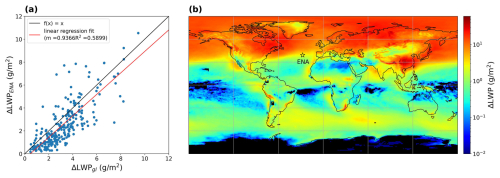
Figure 2Trends in PPE ΔLWP at ENA and globally. (a) ENA ΔLWP regressed on global ΔLWP with a slope of 0.94 and an R2 of 0.60. (b) A map of PPE mean ΔLWP, with ENA's location marked with a star.
2.1.1 Liquid water path
Cloud macrophysical state is characterized by LWP. Observations of LWP are provided by the Microwave Radiometer Retrievals version 2 (MWRRETv2) value-added product (VAP) at ENA. In the MWRRETv2 VAP, LWP is retrieved at a ∼ 15 s resolution with a physical-iterative algorithm detailed in Turner et al. (2007) that utilizes microwave brightness temperatures from the on-site three-channel microwave radiometer and radiosonde temperature, pressure, and humidity profiles (launched three times daily and interpolated to 1 min temporal resolution).
2.1.2 Precipitation
The ARM video disdrometer quantities VAP (VDISQUANTS; Hardin et al., 2020) provides observations of surface rain rate. Surface rain flux is observed at 1 min intervals. While the video disdrometer is considered to be reliable and is frequently used as the truth for validation of satellite retrievals of rainfall (Raupach and Berne, 2015; Schuur et al., 2001; Tokay et al., 2020), the instrument may miss small drops, including those within the drizzle domain, due to wind-induced error (Nešpor et al., 2000). The surface precipitation measurements are inherently limited in that they miss virga because the precipitation evaporates before reaching the surface. Given drizzle and virga's prevalence in ENA's climatology (Wu et al., 2020), this may constitute a component of the sink of cloud water through precipitation. Supplementing surface flux observations of precipitation with radar would not only provide an estimate of the virga and drizzle sink term, but also require the implementation of a radar simulator (Silber et al., 2022), which is beyond the scope of our current study. Potential impacts of this sampling uncertainty are discussed in Sect. 4.
2.1.3 Droplet number concentration
Retrievals of Nd from the ARM droplet number concentration VAP (NDROP) are calculated following the method described in McComiskey et al. (2009). This method uses cloud optical depth obtained from a multifilter rotating shadowband radiometer (MFRSR), cloud base temperature and pressure from interpolated radiosonde observations, LWP from the microwave radiometer, and cloud boundary information from the Active Remote Sensing of Clouds (ARSCL) VAP. Because the MFRSR requires sunlight for its retrieval, Nd retrievals are only available during the daytime. The Nd calculated from NDROP compares favorably with aircraft and other surface remote sensing Nd retrievals, but it tends to overestimate Nd in broken cloud and low-LWP regimes (Zhang et al., 2023).
2.2 The Sixth Community Atmosphere Model (CAM6) perturbed parameter ensemble (PPE)
In GCMs, processes that take place on smaller scales than the model grid size (typically ∼ 100 km) must be parameterized. Parameterizations are a source of uncertainty because of (i) the uncertainty in the coefficients in the parameterization (parametric uncertainty) and (ii) the uncertainty in how processes are represented mathematically within the model and which processes are represented (structural uncertainty). While structural uncertainty is difficult to quantify (Regayre et al., 2020, 2023), we can use perturbed parameter ensembles (PPEs) to systematically explore parametric uncertainties in GCMs (Lee et al., 2011; Sexton et al., 2021).
We leverage a PPE hosted in Community Earth System Model version 2's (CESM2) atmospheric component, the sixth Community Atmosphere Model (CAM6) (Duffy et al., 2023; Eidhammer et al., 2024; Song et al., 2024). The CAM6 PPE is utilized as a tool to link the strength of the LWP adjustment between the PI and the PD atmosphere to present-day variability in clouds and precipitation.
Following the setup in Eidhammer et al. (2024), the CAM6 PPE varies 45 parameters that are sampled across 263 ensemble members. In Eidhammer et al. (2024), these simulations ran for 3 years each; in this study, the simulations were only run for 2 years each. This PPE architecture was designed to investigate uncertainties in subgrid-scale processes relating to cloud microphysics, turbulence, convection, and aerosols – all processes that are likely to be linked to aerosol–cloud interactions. Following this motivation, the perturbed parameters come from four physics schemes: the Cloud Layers Unified By Binormals (CLUBB; Golaz et al., 2002) scheme, version 2 of the Morrison and Gettelman (2008) scheme (MG2; Gettelman and Morrison, 2015), the Modal Aerosol Model (Aerosol in Table 1; Liu et al., 2012), and the Zhang–McFarlane deep convection scheme (ZM; Zhang and McFarlane, 1995). Each ensemble member in the PPE has a different, random, combination of parameter settings. These parameter combinations are generated using Latin hypercube sampling in order to efficiently fill the uncertainty space between parameters (Eidhammer et al., 2024; Lee et al., 2011). The varied parameters, along with their default values (i.e., the values in CAM6) and bounds, are detailed in Table 1.
The CAM6 PPE uses the default CAM6 spatial resolution of 1.25° × 0.9375°. Two scenarios are integrated to calculate adjustment strength in the CAM6 PPE: present day (PD) and preindustrial (PI). Following the setup in Eidhammer et al. (2024), the PD scenario has anthropogenic emissions set from an average for 1995–2005. The PI scenario has emissions set for the same emissions, except for aerosols, which are set for 1850. Again following Eidhammer et al. (2024), sea surface temperatures have been fixed to averages monthly sea temperatures (SSTs) for 1995–2005. Wind and temperature fields are nudged to the Modern-Era Retrospective analysis for Research and Applications version 2 (MERRA2) reanalysis (Molod et al., 2015) at all vertical levels, with a 24 h relaxation time to set the large-scale circulation to be the same between ensemble members and observations following previous studies comparing CAM6 to observations (Gettelman et al., 2020; Song et al., 2024).
Data output is cumbersome for PPEs due to their large number of ensemble members. Higher-frequency outputs and three-dimensional outputs are provided for the grid box containing ENA, allowing for direct comparison with observations. The outputs analyzed from the ENA surface site grid box are detailed in Table 2.
Precipitation rate is calculated by adding together the convective precipitation rate (PRECC) and the large-scale precipitation rate (PRECL). The convective scheme in this model (ZM) is not directly impacted by drop number or activation. Cloud droplet number concentration is calculated by dividing vertically resolved, grid-average cloud water number concentration (AWNC) by liquid cloud fraction (CLOUD), giving the in-cloud droplet number concentration. A vertically distributed Nd calculation is obtained and then averaged through liquid clouds in the column. We believe this to be the best analogue for NDROP from CAM6, although it should be noted that NDROP data are constrained to single-layer clouds, and there is no way to do this in a GCM. Model LWP (TGCLDLWP) is directly comparable to microwave radiometer LWP.
This study seeks to provide observational constraints on aerosol–cloud adjustments based on observations from ENA. The outputs used to calculate aerosol–cloud adjustments between PI and PD are detailed in Table 3.
Due to space constraints, the three-dimensional output saved at ENA is not available over the globe, and cloud-top Nd is used in the calculation of a global Nd. To calculate cloud-top Nd, average cloud-top droplet number (ACTNL) is divided by fractional occurrence of cloud-top liquid (FCTL).
2.3 Gaussian process emulation
PPEs are useful for exploring the parametric uncertainty, but it would be prohibitively computationally expensive to explore that uncertainty space systematically because the number of ensemble members needed to regularly sample a p-dimensional parameter space with n samples in each dimension is np (Lee et al., 2011). To explore the parameter space efficiently, we leverage the Earth System Emulator (ESEm) package (Watson-Parris et al., 2021) to build Gaussian process (GP) emulators. By generating a multivariate distribution via GP regression of ensemble output (for example, LWP) on input ensemble parameters, we can emulate the relationship between sampled parameters and outputs. This is advantageous, as this sampling of the 45-dimensional parameter space across 263 PPE members is, with an even sampling of the space, a collection of discrete points rather than a smooth surface, so emulation is critical to provide statistically meaningful results and understand linkages between processes and model behavior. This approach has been used in many other model-evaluation studies (McCoy et al., 2020b; Regayre et al., 2018, 2020, 2023; Song et al., 2024; Watson-Parris et al., 2020).
To create an emulator, training samples and testing samples from the PPE members are randomly chosen. Of the ensemble members available, 15 are set aside as the testing sample, and the rest are used for training. To validate these emulators, the testing portion of the dataset withheld from training is compared with the emulator prediction. GPs carry an estimate of their own prediction confidence. If the emulator is good, 95 % of the test dataset should overlap with the 95 % confidence interval for each prediction (Lee et al., 2011).
After the emulators are validated, 10 million emulated ensemble members (hereafter referred to as emulates) are created by randomly sampling the 45 input parameters within their individual minimum and maximum bounds (see Table 1). This gives a smooth surface to examine the model's uncertainty space.
Because we have no observational record of PI cloud properties, we use the difference between PD and PI PPE scenarios to make inferences about the PI to PD adjustment strength. When discussing the difference in a modeled quantity across PD and PI, Δ is used. For example, ΔLWP = PD LWP − PI LWP.
We create emulators for ENA median ln LWP (median ln LWPENA), ENA median ln Nd (median ln Nd, ENA), ENA mean-state P (), ENA ), ENA (), ENA (), PD−PI change in average global LWP (ΔLWPgl), and PD−PI change in average global Nd (ΔNd, gl). We then observationally constrain the parameter range by removing each emulate that does not contain the observed value within the emulate's 95 % confidence interval. In the case of the covariances, the observation and its 95 % confidence interval from the standard error of the regression are used for constraint. For the other variables, because we are using average values from a large dataset (5 years of continuous observations), we are unconcerned with random uncertainty and only utilize the single observation value in constraint. For all testing emulates in all emulators, there is 100 % overlap of PPE validation data with the emulates' 95 % confidence interval (Fig. 3). The linear regression fit and associated R2 for each validation are also provided in Fig. 3.
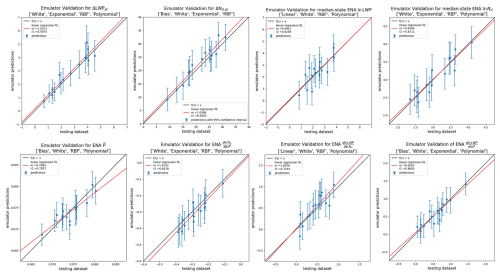
Figure 3Validation plots for each emulator. For each emulator, the withheld test runs are plotted against emulator predictions. The vertical blue error bars are 95 % confidence intervals of the emulate uncertainty. The explained variance and slope are noted for each emulator along with the kernels used to generate the emulator.
3.1 Developing a causally aware framework for aerosol–cloud adjustments
The relationship between Nd and LWP does not exist in isolation (Fig. 1). Confounding sources of variability make it difficult to discern the causal link flowing from Nd to LWP based on observed covariability between these terms. We illustrate this by examining the relationship between Nd and LWP in CAM6 in the PI and PD in the Northern Hemisphere (NH) (Fig. 4a). This is similar to previous studies examining the observed PD relationship between LWP and Nd (Gryspeerdt et al., 2019), but within CAM6, we can contrast PD and PI relationships between LWP and Nd. The lack of agreement between the PI and PD illustrates that we cannot assume the observable covariation between Nd and LWP is, on its own, predictive of the transient response of LWP to changes in Nd driven by anthropogenic aerosols.
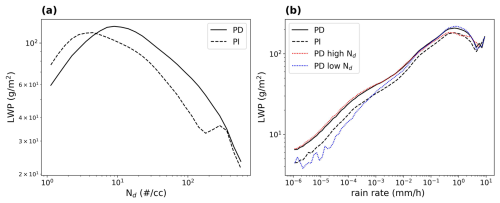
Figure 4Northern Hemisphere (30–70° N) PD and PI LWP in CAM6 binned by Nd (a) and rain rate (b). In (b), PD LWP is shown separated into the top and bottom terciles of Nd. The Northern Hemisphere is used specifically in this figure to highlight the effect of aerosol–cloud adjustments since this is the region in which we would expect to see the most anthropogenic aerosol emissions (and thus the highest PD−PI difference).
Given the numerous confounding factors acting on Nd and LWP (Gryspeerdt et al., 2019; Stevens and Feingold, 2009), a more complex analysis than examining covariance between Nd and LWP is required to isolate a causal relationship. Previous studies have described coalescence scavenging of droplets acting to create a negative correlation between LWP and Nd (Gryspeerdt et al., 2019; McCoy et al., 2020a). To illustrate the importance of this confounding factor, we examine PI and PD LWP binned by precipitation rate (Fig. 4b). In each bin of precipitation rate, coalescence scavenging is approximately constant. While holding coalescence scavenging constant, we contrast PI and PD LWP and PD LWP binned into the top and bottom terciles of Nd (Fig. 4b). Precipitation suppression in CAM6 leads to higher LWP at higher Nd and a constant rain rate. For low rain rates, the high-Nd regime has a distinctly higher LWP than its low-Nd counterpart in the same precipitation bin.
The relationship between LWP and Nd in the PD is not predictive of PI to PD changes in LWP (Fig. 4a). We cannot rely on PD covariance between LWP and Nd to predict aerosol–cloud adjustments, and we need to consider non-causal sources of covariance between LWP and Nd in developing a constraint on aerosol–cloud adjustments from the PD (Mahfouz et al., 2024; Mülmenstädt et al., 2024a, b). The following covariances, which are intended to contain information about processes illustrated in Fig. 1, are considered:
-
for the below-cloud scavenging of droplets from precipitation;
-
for autoconversion, the process by which cloud droplets collide with each other to form drizzle drops, which ultimately leave the cloud via precipitation;
-
for the observed susceptibility of cloud liquid water content to different droplet number concentrations. This can be thought of as an observed adjustment term, although, as discussed above, it does not describe a causal relationship between Nd and LWP.
We argue, consistent with previous studies (Fons et al., 2023; Glassmeier et al., 2021; Gryspeerdt et al., 2019; McCoy et al., 2020a; Mülmenstädt et al., 2024b), that to infer the strength of aerosol–cloud adjustments, we need to consider the confounding relationship that flows from LWP to precipitation and to Nd. By considering covariances between LWP and P and Nd, we can estimate the strength of this term. To characterize aerosol–cloud adjustments in the context of these covariances, we need to have an underlying causal model. Here, we leverage the CAM6 PPE in this capacity to allow us to build a framework linking the aerosol–cloud adjustment due to anthropogenic aerosols to observed PD covariance between LWP, P, and Nd. We constrain the PPE by the observed mean states of LWP, P, and Nd and the covariances between them (Table 4). By selecting the parameter space where PPE ensemble members agree with the quantities in Table 4 at ENA, we can link PD observations to the ΔLWP due to anthropogenic aerosol emissions.
Table 4Base-state variables and covariances at ENA used in this study to constrain aerosol–cloud adjustments.
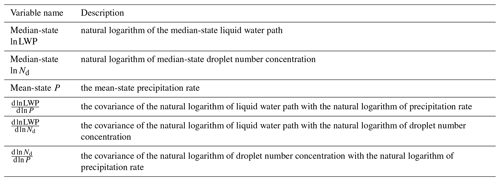
One concern is how relevant observations at ENA are to understanding global-mean aerosol–cloud adjustment and, by extension, ERFaci. However, across the CAM6 PPE cloud adjustments at ENA (ΔLWPENA) are found to be correlated with global adjustments (ΔLWPgl) with a slope of 0.94 and an R2 of 0.60 (Fig. 2a). This correspondence between aerosol–cloud adjustments at ENA and global-mean aerosol–cloud adjustments is sensible because ENA straddles the border of the extratropics and subtropics (Fig. 2b); we expect that the same aerosol, cloud, and precipitation processes being observed at ENA are relevant over the other oceans in these regions where marine stratocumulus dominates.
In the PPE, we find differences in the predictive ability of ΔNd for ΔLWP in the local (ENA) and global regimes. Specifically, we find that while ΔNd alone is not a good predictor of ΔLWP in the global regime (as expected following Fig. 4), it has a higher predictive ability in the ENA regime (Fig. 5). This indicates that in CAM6 local-scale adjustments are sensitive to local perturbations in Nd, while global-scale adjustments are more influenced by physical processes.
3.2 Model–observation comparison
Before applying the framework described in the preceding section to constrain aerosol–cloud adjustments, we characterize PD Nd, LWP, and P at ENA in the observations and in the CAM6 PPE (Table 4). The observations are found to fall within the range of the PPE (Fig. 6).

Figure 6Distributions of median ln LWP, median ln Nd, and mean P across the PPE with the observational equivalents depicted by black bars.
In the PPE and the observations, the mean state of precipitation rate is used instead of the median state because the video disdrometer cannot see extremely low precipitation rates, which are prevalent in the PPE data over ENA, consistent with most GCMs (Stephens et al., 2010). Differences between observed and PPE precipitation rate may also be due to sampling differences between averaged CAM6 data from a largely oceanic grid cell ∼ 100 × 100 km2 and observation data from a single point on an island.
Covariances between variables are characterized by the linear regression slope of their constituent variables (e.g., is the slope of the regression of ln LWP on ln P). We observe to be −0.236 with a 95 % confidence interval of ±0.051 (from the standard error of the linear regression), to be 0.338 with a 95 % confidence interval of ±0.009, and to be −0.258 ± 0.092 (Fig. 7). All values are unitless. These slopes were used to scale the shaded arrows in Fig. 1. To match the 3 h temporal resolution of the PPE data used to calculate the PPE covariances, we have binned the observations to 3 h. As expected, there is a strong positive correlation between P and LWP, with an r value of 0.741 (Fig. 7). Consistent with previous satellite-based studies there is a negative correlation between LWP and Nd (Gryspeerdt et al., 2019). Consistent with our understanding of coalescence scavenging, there is a negative correlation between P and Nd (Kang et al., 2022; Wood et al., 2012). Observed and are closer to the PPE distribution means (Fig. 8), while observed is on the very low end of PPE predictions, with an opposite sign compared to most of the PPE distribution. This result is discussed in more detail in Sect. 4.
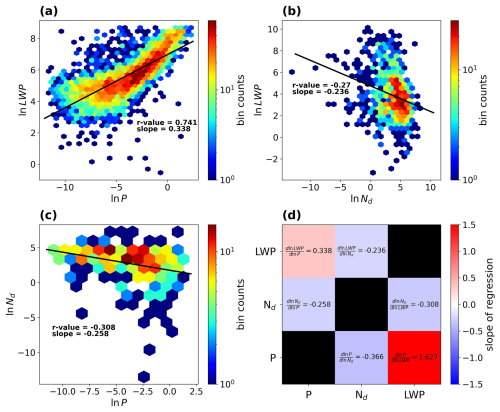
Figure 7Observed covariances at ENA, derived with observations binned to 3 h temporal resolution. Two-dimensional histograms relating LWP to P (a), LWP to Nd (b), and Nd to P (c). , , and derived from linear regressions are noted in (a), (b), and (c) and summarized in (d).

Figure 8Distributions of , and across the PPE with the observational equivalents depicted by black bars.
We leverage the CAM6 PPE to understand linkages between covariances and states of LWP, Nd, and P and parameterized processes in CAM6. This is done by correlating values of perturbed parameters (Table 1) with mean states and covariances (Table 4) across the PPE (Fig. 9). While many of these correlations are low, there are stronger correlations associated with cloud and precipitation process parameters. This supports the utility of the framework in this study since it is picking out information about these processes.
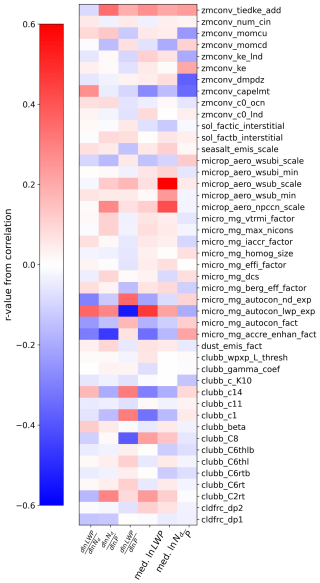
Figure 9Correlations between covariances and PPE parameters at ENA. Note that the color bar bounds span between −0.6 and +0.6, with the highest-magnitude r value recorded at 0.55.
We briefly discuss some of the stronger correlations between observables and processes and how these may link processes and observed quantities in a qualitative sense. Within CAM6, aerosol–cloud adjustments should occur through precipitation suppression operating through the autoconversion parameterization. This can be seen as a grouping of strong correlations related to micro_mg_autocon_ parameters (see Table 1 for descriptions). The inferred strength of coalescence scavenging () correlates strongly with the accretion enhancement factor (micro_mg_accre_enhan_fact). Mean-state Nd is strongly correlated with the subgrid velocity and liquid activation parameters (micro_aero_npccn_scale, microp_aero_wsub_min, and microp_aero_wsub_scale). Several parameters are important for setting the median-state LWP, and strong correlations can be seen relating median-state LWP to CLUBB parameters that relate to skewness in vertical velocity (clubb_c1, clubb_C8, and clubb_c14), which results in changes in cloud liquid content and, subsequently, reflectivity (Eidhammer et al., 2024; Guo et al., 2014). Mean-state precipitation properties are correlated with several parameters in the ZM convection scheme that are important for setting the amount and strength of convection and likely affect the creation of convective precipitation (zmconv_tiedke_add, zmconv_momcu, zmconv_ke_lnd, zmcomv_ke, zconv_dmpdz, and zmconv_capelmt).
3.3 Constraining LWP adjustment strength from present-day observations
We seek to constrain aerosol–cloud adjustment strength in CAM6 by leveraging process-scale observations at ENA. As discussed in Sect. 3.1, we need to simultaneously consider relationships between P, LWP, and Nd. Following the procedure described in Sect. 2.3 on Gaussian process emulation, we constrain the PPE by removing GP emulates that do not contain the observation (Table 4) within their variance. Before constraining global adjustments, it is useful to understand how each observation is constraining its own variable within the emulated PPE. In Fig. 10, the distribution of each variable in the emulator field is shown overlaid by the distribution of emulates that are observationally constrained by that variable. Observations are found to be within the PPE distribution for all variables.
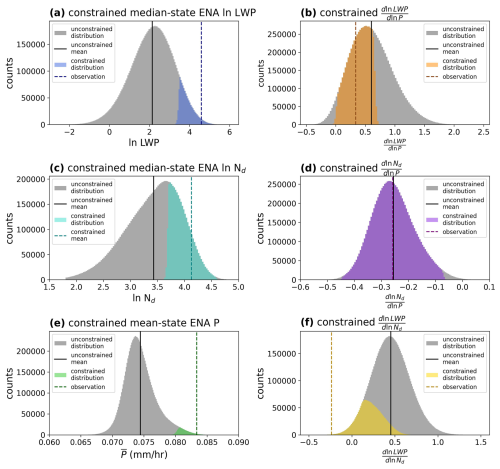
Figure 10Distributions of PPE emulates with the observationally constrained regions shaded in. For each plot, the variable is only being constrained by its associated observation. For instance, the shaded region in (a) is the subset of emulates that contain the observed value within their respective variances; in other words, the emulates of median-state ENA ln LWP that are observationally constrained. Panels (b), (c), (d), (e), and (f) are the same for their respective variables.
When we use these same individual constraints to examine global-mean aerosol–cloud adjustments (ΔLWPgl), we see that observational constraints do not uniformly pull ΔLWPgl one way or the other (Fig. 11). The degree to which an observational constraint is effective at reducing the 95 % confidence interval for ΔLWP is determined by (i) the distance between the observation and the mean of the distribution and (ii) the relative variance of the emulates within the distribution. This illustrates why mean-state precipitation is such a powerful constraint: the observation is relatively far from the mean, out towards the right tail of the distribution (Fig. 10e), while the average relative variance is relatively low. Intuitively, (Fig. 10f) should be one of the strongest constraints on aerosol–cloud adjustments given its proximity to the processes responsible for aerosol–cloud adjustments (Fig. 1) and its relatively large distance from the mean. However, this emulator was relatively uncertain (Fig. 3), and the standard error from the linear regression was relatively high (Sect. 3.2), so the observation remains within the permissible range for many emulates.
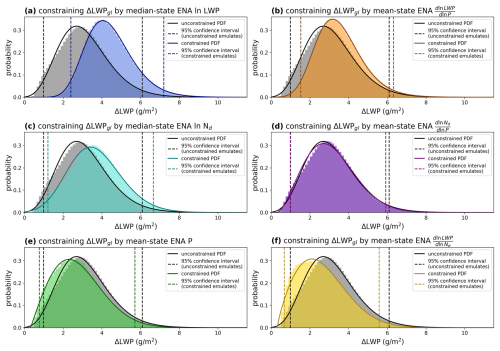
Figure 11ΔLWPgl is constrained by individual constraints, with the color-shaded region in each plot representing the constrained distribution and the gray region representing the prior distribution. These constraints are (a) median-state ENA ln LWP, (b) , (c) median-state ENA ln Nd, (d) , (e) mean-state ENA P, and (f) . Vertical black lines are the 95 % CIs for unconstrained emulate distributions, and colored vertical lines are the 95 % CIs for constrained emulate distributions.
After discarding all invalid emulates, we are left with only the emulates that agree with the observations. This subset of emulates is the observationally constrained dataset that is analyzed for most of the remainder of this paper.
Constraining ΔLWP by the variables in Table 4 removes the vast majority of emulates, leaving 11 053 (0.11 %) of the original 107 emulates. While this is a small fraction of the total number of prior emulates, 45 dimensions are being constrained, and even moderate constraints in a few dimensions scale quickly. For instance, a fractional reduction in the range of f in n dimensions scales as fn remaining emulates, and the reduction described above is equivalent to constraining to 50 % of the range of six parameters.
The constraints on the prior parameter range results in a constraint on ΔLWPgl (Fig. 12). The prior distributions of ΔLWPgl range from 0.99 to 6.64 g m−2, while the constrained ΔLWPgl ranges from 2.08 to 6.87 g m−2; ΔLWPgl is constrained by 15 % (calculated by the change of confidence intervals). The observational constraint of ΔLWPgl does not strongly skew the distribution away from the CAM6 default adjustments.
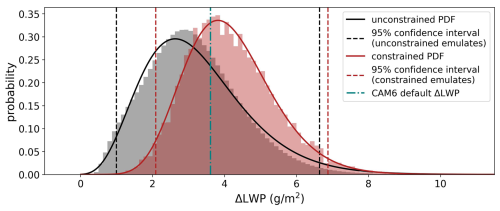
Figure 12Constrained and unconstrained distributions for the global ΔLWP regime. Unconstrained 95 % confidence intervals are bounded by dashed black lines, and constrained 95 % confidence intervals are bounded by dashed red lines
When examining the parameters constrained by the observations, we see substantial constraints in the distributions of parameters in the CLUBB, MG2, and ZM physics schemes (Fig. 13). This is consistent with the correlations between variables in Table 4 and the CAM6 parameters (Fig. 9) as well as our a priori expectations based on underlying model physics. Autoconversion is the process through which precipitation is suppressed in aerosol cloud adjustments in CAM6, and we find that the associated terms within MG2 (micro_mg_autocon_fact, micro_mg_autocon_lwp_exp, micro_mg_autocon_nd_exp, and micro_mg_accre_enhan_fact; see Table 1 for details) are constrained in that the posterior distribution is very different than the flat prior distribution for each parameter. Additionally, we find that several parameters that are important for setting the mean state of Nd (micro_aero_npccn_scale, micro_aero_wsub_min, and micro_aero_wsub_scale), convective versus large-scale precipitation occurrence (cldfrc_dp2, zmconv_capelmt, zmconv_dmpdz, and zmconv_tiedke_add), and other boundary layer cloud properties (clubb_C2rt, clubb_c8, clubb_c14, clubb_c11, clubb_c1) (Eidhammer et al., 2024; Guo et al., 2014) are substantially constrained. Based on the singularly tight constraint of zmconv_capelmt, we posit that this parameter should be limited to a smaller range in future PPE studies in this area.
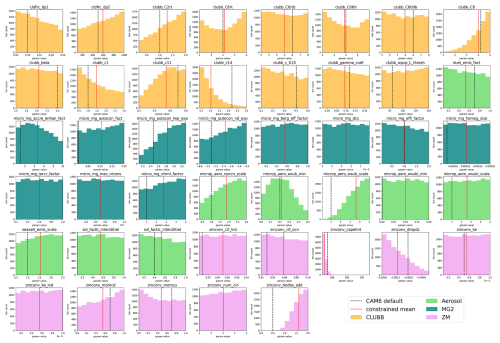
Figure 13Grid of the distribution of PPE parameter values within the constrained set of 11 053 emulates, with each distribution colored by the parameter category it is in as detailed in Sect. 2.2. These categories are CLUBB (orange), aerosols (green), MG2 (teal), and ZM (pink). For more information on the parameters and their bounds, see Table 1.
Finally, we investigate the relationship between the emulated distributions of ΔLWPgl and (Fig. 14) and whether their covariance, particularly the correspondence between negative and positive ΔLWPgl, is causal. ΔLWPgl and are clearly related, but the processes driving Nd and LWP and their linkage via adjustments are more complex than can be captured by a simple causal relationship between Nd and LWP characterized by a linear regression of LWP on Nd.
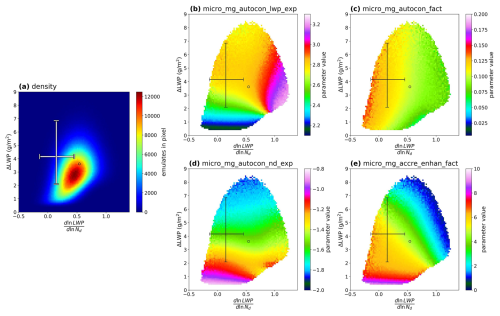
Figure 14(a) The density of emulated distributions and (b–e) how autoconversion-related parameters are distributed. The error bar represents the 95 % confidence interval of the observationally constrained distribution on each axis, and the circle shows the location of the CAM6 default runs. Panel (a) depicts the density of the 107 emulates within the emulator space. Panels (b), (c), and (d) depict the average distributions of micro_mg_autocon_lwp_exp, micro_mg_autocon_fact, micro_mg_autocon_nd_exp, and micro_mg_accre_enhan_fact within this space. In (b), (c), (d), and (e), pixels that contain fewer than 50 emulates have been masked.
To interpret these results, it is useful to understand how autoconversion and accretion are parameterized in GCMs. In CAM6's MG2 (Gettelman and Morrison, 2015) and elsewhere (Jing et al., 2019; Michibata and Takemura, 2015), autoconversion is represented as a power law function of the form
where Raut is the rate of autoconversion of droplets into rain; Lc denotes cloud liquid water content; and Caut, α, and β are constants. Caut is the autoconversion enhancement factor, represented in the model as micro_mg_autocon_fact; α alters the exponent on Lc, represented in the model as micro_mg_lwp_exp; and β alters the exponent on Nd, represented in the model as micro_mg_nd_exp. β in the CAM6 PPE is a negative number with bounds between −2.0 and −0.8. Caut and α are positive in the CAM6 PPE with bounds of 0.005 to 0.2 and 2.10 to 3.30, respectively. Adjustments are driven by precipitation suppression as characterized by the exponent on Nd.
Accretion is parameterized in CAM6's MG2 (Gettelman and Morrison, 2015) and elsewhere (Michibata and Takemura, 2015) with the form
where Caccre is micro_mg_accre_enhan_fact and qr is the mixing ratio of drizzle. In the CAM6 PPE, micro_mg_accre_enhan_fact is a positive number with bounds of 0.0 and 10.0. Like autoconversion, accretion can be thought of as a sink of cloud water and scales negatively with ΔLWP and (Fig. 14e).
Observed covariability between Nd and LWP is driven by coalescence scavenging and is strongly determined by the autoconversion enhancement factor and more moderately determined by the accretion enhancement factor. This is shown in Fig. 14b–e, where it can be seen that micro_mg_autocon_fact scales primarily with , micro_mg_nd_exp scales primarily with ΔLWP, and micro_mg_autocon_lwp and micro_mg_accre_enhan_fact scale with both.
The relationship between ΔLWP and autoconversion parameters can be understood using the steady-state conceptual model in Song et al. (2024) (their Eqs. S1–S5). In the PI and PD clouds are at a steady-state balance between sources and sinks. The sink term is enforced by the large-scale moisture convergence, which is in turn enforced by the global pattern of sea surface temperature. Considering autoconversion to be the dominant sink term of cloud, the tendency from autoconversion should be approximately the same in PI and PD.
which can be solved for the change in ln Lc:
While highly idealized, this provides some insight into the behavior in Fig. 14. The autoconversion scale factor (Caut or micro_mg_autocon_fact in Fig. 14c) does not impact the adjustment strength, but it does affect the covariance between Nd and LWP through coalescence scavenging (Wood et al., 2012) by setting the precipitation rate. This is consistent with the lack of dependence of ΔLWP on the autoconversion scale factor and the strong dependence of on this parameter in Fig. 14c. As expected, aerosol cloud adjustments scale very strongly with the Nd exponent (β or micro_mg_nd_exp in Fig. 14d), while the observed covariability between Nd and LWP characterized by is not strongly affected by this term because of its weak overall contribution to setting precipitation rates and, by extension, coalescence scavenging. This is consistent with the strong dependence of ΔLWP in Fig. 14d on micro_mg_nd_exp and the lacking dependence of on this parameter. The modulation of both adjustments and PD covariability between Nd and LWP by α is less easily interpreted because both the adjustment strength and PD Nd–LWP covariability are substantially affected by this term.
If we apply a similar logic to accretion, we get
which can be solved for the change in ln Lc:
This can be read as the strength of adjustments from accretion being dependent on the change in precipitation rates, which we have previously described as strongly scaled by autoconversion parameterizations. Although accretion is important for understanding the change in adjustments and indeed follows a similar behavior to micro_mg_autocon_fact, it is less easily disentangled from the system than micro_mg_autocon_fact given its dependence on qr, a variable modified by accretion's own parameter micro_mg_accre_enhan_fact as well as the previously discussed autoconversion parameters. Following Eqs. (2) and (6), the negative correlation between micro_mg_accre_enhan_fact and both and ΔLWP is expected: the rate of accretion is an important part of setting precipitation rates (and, by extension, the rate of coalescence), and modified precipitation rates are the critical process for adjustments.
While precipitation suppression is the main control on adjustments in the CAM6 PPE, this does not project directly onto . The explained variance (R2) in adjustment strength (ΔLWPgl) by (Fig. 14a) is only 12 %. This highlights the importance of considering other confounding processes when attempting to use observed covariation between Nd and LWP as a constraint on aerosol cloud adjustments, as has been done in assessments of the total aerosol forcing (Bellouin et al., 2020). Because adjustments at ENA correlate well with global adjustments (Fig. 2), it is presumed that this weak causality between ENA and global ΔLWP scales accordingly.
Aerosol–cloud adjustments are described in terms of interactions between Nd and LWP, but these processes occur in the context of precipitation and its confounding effects, driven by coalescence scavenging (Figs. 1 and 4). We find that surface observations have utility in constraining global aerosol–cloud adjustments despite their poor sampling of the global atmosphere (Fig. 2). Surface observations from the DOE ARM site at ENA provide a broad suite of cloud and precipitation measurements (Wood et al., 2015) that enable this analysis.
The constraint of ΔLWPgl found in this paper is relatively weak, decreasing the prior distribution by only 15 % (Fig. 12) from the variance found in the CAM6 PPE. This can potentially be attributed to the inherent limitations in constraining to a single surface observatory as opposed to broader climatology. While ENA (and other similar surface observatories) provide a unique and useful venue for observing fine-scale processes, it should not be expected that ENA alone will be able to tightly constrain ΔLWPgl. For clues as to the path forward, it is useful to compare the results of this study to Song et al. (2024), which constrains ΔLWPgl in the same PPE to satellite measurements of globally averaged LWP, Nd, and upwelling top-of-atmosphere shortwave radiation. When comparing the constrained ΔLWPgl ranges between these two studies, while neither constraint is especially strong on its own, each constraint rules out different extremes in ΔLWPgl. This work shows a larger minimum constrained ΔLWPgl (2.08 g m−2); Song et al., 2024, shows a smaller maximum constrained ΔLWPgl (4.33 g m−2). While this should not be considered a strict scientific comparison, it suggests that a more robust constraint can be found by constraining on the fine scale (e.g., surface-observed precipitation) and the broader climate scale (e.g., satellite-observed average global upwelling shortwave radiation) simultaneously. This is an idea we will be exploring in future work.
By looking at other studies in this way, we may also see value in some of the parameters that appear to be unconstrained in Fig. 13. In Eidhammer et al. (2024), a CAM6 PPE of the same architecture as this paper was constrained off satellite-observed average upwelling radiation and satellite-observed average LWP. In Fig. 10 of Eidhammer et al. (2024), it can be seen that sol_factb_interstitial shows signs of relatively strong constraint; by contrast, in this study, the posterior distribution of sol_factb_interstitial shows no signs of constraint (Fig. 13). This parameter and others like it may be important for setting climate-accurate aerosol–cloud adjustments in a way that is not immediately obvious based on this study alone, so we cannot rule them out.
Observed state and covariance metrics examined in this study (Table 4) were within the range produced by the PPE (Figs. 6 and 8). The regression of LWP on Nd (), which has been used in previous studies to characterize aerosol–cloud adjustments (Bellouin et al., 2020), barely overlapped between the PPE and observations (Fig. 8). We share four potential hypotheses to explain this behavior and suggested pathways to evaluate these hypotheses: (i) missing processes in CAM6, (ii) insufficiently broad PPE parameter priors, (iii) sampling differences between the CAM6 grid cell and the ENA observation footprint, and (iv) observational uncertainty. We briefly discuss each below.
The parameterizations in CAM6 only explicitly address aerosol–cloud adjustments that occur through precipitation suppression. CAM6 does not contain parameterizations that fully treat size-dependent entrainment. Size-dependent entrainment is partially addressed in CAM6 through size-dependent droplet sedimentation (Morrison and Gettelman, 2008). An increase of CCNs in a cloud, decreasing the average droplet size, decreases the effect of sedimentation which, in turn, increases entrainment. Through this process, there is a partial representation of the processes leading to size-dependent entrainment in CAM6. These relationships are illustrated succinctly in Fig. 1 of Karset et al. (2020).
The lack of a complete parameterization of size-dependent entrainment is common across GCMs (Jing et al., 2019; Karset et al., 2020; Michibata and Takemura, 2015). One possibility would be to implement size-dependent entrainment in a future version of the PPE, following previous studies, although implementation of this parameterization in a GCM was not found to substantially affect adjustment strength (Karset et al., 2020). A challenge in this approach will be determining if the structure of the size-dependent entrainment parameterization is reasonable and selecting cases and regimes with sufficient measurements to constrain the size-dependent entrainment process to isolate it from other confounding processes. We stress that establishing the necessity of a size-dependent entrainment parameterization to accurately represent aerosol–cloud adjustments appears to require careful analysis to distinguish between thinning due to size-dependent entrainment and non-causal anticorrelation between Nd and LWP driven by precipitation scavenging (Mahfouz et al., 2024; McCoy et al., 2020a; Mülmenstädt et al., 2024b).
While the prior distribution of is mostly more positive than observations, the PPE prior and observations from ENA do overlap. A simple explanation of the occurrence of observed at the edge of the PPE prior may be that the prior distribution for the CAM6 PPE Nd exponent (micro_mg_autocon_nd_exp; Table 1) – a parameter that governs most of the aerosol–cloud adjustment process in CAM6 (shown in Fig. 14c for CAM6 and in other GCMs; Jing et al., 2019) – may have been too narrow when the CAM6 PPE was originally designed (Eidhammer et al., 2024). Given the dependence of on micro_mg_autocon_fact and micro_mg_accre_enhan_fact, in future iterations of this and other PPEs examining aerosol–cloud adjustments, we suggest considering high autoconversion and accretion enhancement factors. This should create more ensemble members with negative . This approach would be the most useful combined with the implementation of a size-dependent entrainment parameterization as discussed above to evaluate the relative importance of these two processes in producing observed present-day cloud and precipitation behavior.
Another source of disagreement may be the disparity in scale between the CAM6 grid and the ARM sampling footprint. Model output at finer spatial resolutions would allow for the characterization of the tolerance when comparing GCM grid cell properties to ENA observations. One possibility would be to leverage large-eddy simulations (LESs) to characterize the relationship between observations at a point to the GCM grid scale. At the time of writing, the LES ARM Symbiotic Simulation and Observation (LASSO) project (Gustafson et al., 2020) for ENA is in the planning phase and may be useful for future constraint studies. LESs in combination with ENA observations would enable further quantification of the impact on adjustments, and more broadly ERFaci, of subgrid-scale processes that are not explicitly parameterized in GCMs. For example, ENA aerosol–cloud–precipitation systems are influenced by varied mesoscale cloud organization (McCoy et al., 2023; Zhou and Bretherton, 2019) and sometimes are buffered against precipitation removal by the presence of small, Aitken-mode aerosols (McCoy et al., 2024). Both of these mechanisms influence the radiative properties and responses to aerosols of the cloud systems, but their resulting behaviors are incompletely represented in CAM6 (McCoy et al., 2021, 2023; Zhou et al., 2021).
From an observational perspective, there remains uncertainty related to observation (or lack thereof) of light precipitation and virga. Drizzle and virga conditions – two precipitation regimes for which the disdrometer is inadequately equipped to observe – are prevalent at ENA (Wu et al., 2020). To account for this, future work in this area should utilize remote sensing retrievals such as Ka-band ARM zenith radar (KAZR) reflectivity (Ghate and Cadeddu, 2019; Wu et al., 2020) to account for these otherwise missed precipitation events. The reflectivity product available from CAM6 is not adequate to make a comparison to ENA's KAZR. To facilitate this comparison, instrument simulators such as the Earth Model Column Collaboratory (EMC2) (Silber et al., 2022) are required and may be a promising avenue for future constraint studies motivated by our finding that precipitation played an important role in our constraint of aerosol–cloud adjustments. As it stands, we are unable to disentangle these last two points, but a more accurate observation would help eliminate at least one vector for uncertainty. We expect that a higher-sensitivity precipitation measurement would bring down towards the PPE distribution rather than further away as there would be a higher number of low-rain-rate observations.
In summary, there are several avenues we can take to build on the constraint framework laid out here. However, based on our findings, in a narrow sense, we did not find a structural disagreement between ENA observations and the CAM6 model. Critically, although the negative correlation between Nd and LWP is used to support a prevalent thinning of cloud in response to increased aerosols in our assessments of aerosol forcing (Bellouin et al., 2020), we do not find that this is necessarily the case. Following the results from Mülmenstädt et al. (2024b), the observed negative from this study and elsewhere is not in contradiction with a positive ΔLWPgl. CAM6 can, for a given value of , produce a broad swath of ΔLWPgl values (Fig. 14b–e), supporting the idea that this metric is not strongly predictive of PD-PI adjustments.
We present a framework for constraining aerosol–cloud adjustments using mean-state variables and covariances (Table 4). Our framework unites causally ambiguous present-day observations and a perturbed parameter ensemble (PPE) hosted in the CAM6 global climate model (GCM) to (i) provide constraints on aerosol–cloud adjustments in liquid water path (LWP) and (ii) link this constraint to different parameterized processes. Observations from the Eastern North Atlantic (ENA) were used to constrain global-mean aerosol–cloud adjustments. This constraint is the result of selecting model configurations where precipitation rate (P), liquid water path (LWP), droplet number concentration (Nd), and their covariance: , , and extracted from the PPE at ENA match their observed equivalents. Response in global-mean LWP to anthropogenic aerosols is constrained to be between 2.08 and 6.87 g m−2, which is a 15 % reduction from the prior range in the PPE. Within this constrained emulator space, we see constraint (based intuitively on the shape of the constrained distribution) on 18 out of 45 of the perturbed parameters (Fig. 13). Constrained parameters match our a priori expectations for processes that are relevant to aerosol cloud adjustments and set cloud and precipitation states. These processes include the autoconversion parameterization that drives aerosol–cloud adjustments in GCMs (Jing et al., 2019); the accretion parameterization, which is comparable with constraining confounding linkages between LWP, precipitation, and Nd; and cloud and convection parameters that are important for setting the mean-state cloudiness and precipitation.
As demonstrated in Fig. 14, confounding effects from coalescence scavenging (Gryspeerdt et al., 2019; McCoy et al., 2020a) can operate in conjunction with autoconversion-driven precipitation suppression to reproduce this negative correlation between LWP and Nd. We stress that our results do not necessarily rule out size-dependent evaporation and entrainment as an important process in setting aerosol–cloud adjustments, but we do find that this process is not necessary to produce observed present-day behavior and present-day observations of clouds and precipitation at ENA are consistent with a moderate increase in cloud liquid water path in response to anthropogenic aerosols.
Data were obtained from the Atmospheric Radiation Measurement (ARM) user facility, a US Department of Energy (DOE) Office of Science user facility managed by the Biological and Environmental Research Program. The following data citations are provided for each ARM data product: droplet number concentration (NDROPMFRSR) (https://doi.org/10.5439/1131339, Riihimaki et al., 2024), MWR Retrievals with MWRRET version 2 (MWRRET2TURN) (https://doi.org/10.5439/1566156, Gaustad and Zhang, 2024), and Video Disdrometer VAP (VDISQUANTS) (https://doi.org/10.5439/1592683, Hardin et al., 2024). CAM6 PPE data (https://doi.org/10.26024/bzne-yf09, Eidhammer et al., 2022) are available at https://data.ucar.edu/dataset/cesm2-2-cam6-perturbed-parameter-ensemble-ppe (last access: 1 July 2024).
AM, DTM, and HM participated in conceptualization and methodology. AM and DTM performed formal analysis. DTM and HM led project administration and acquired funding. AM and DTM: writing (original draft preparation). AM, DTM, HM, ILM, AG, TE: writing (review and editing). AG, DTM, AM, CS: data curation.
The contact author has declared that none of the authors has any competing interests.
The statements, findings, conclusions, and recommendations are those of the author(s) and do not necessarily reflect the views of NOAA or the US Department of Commerce.
Publisher’s note: Copernicus Publications remains neutral with regard to jurisdictional claims made in the text, published maps, institutional affiliations, or any other geographical representation in this paper. While Copernicus Publications makes every effort to include appropriate place names, the final responsibility lies with the authors.
The authors thank the editor and reviewers for their time improving this paper.
August Mikkelsen, Hamish Gordon, and Daniel T. McCoy were supported by a US Department of Energy's Atmospheric System Research federal award (grant no. DE-SC0022227), and Daniel T. McCoy was supported by US Department of Energy's Established Program to Stimulate Competitive Research (grant no. DE-SC0024161). Isabel L. McCoy was supported by NOAA cooperative agreements NA17OAR4320101 and NA22OAR4320151. Ci Song was supported by NASA Grant 80NSSC21K2014. We would like to acknowledge the use of computational resources (https://doi.org/10.5065/D6RX99HX, Computational And Information Systems Laboratory, 2017) at the NCAR-Wyoming Supercomputing Center provided by the National Science Foundation and the State of Wyoming and supported by NCAR's Computational and Information Systems Laboratory. The Pacific Northwest National Laboratory is operated for the US Department of Energy by the Battelle Memorial Institute under contract no. DE-AC05-76RL01830. Trude Eidhammer was supported by the National Aeronautics and Space Administration (grant nos. 80NSSC17K0073 and 80NSSC21K1499).
This paper was edited by Matthew Lebsock and reviewed by two anonymous referees.
Ackerman, A. S., Kirkpatrick, M. P., Stevens, D. E., and Toon, O. B.: The impact of humidity above stratiform clouds on indirect aerosol climate forcing, Nature, 432, 1014–1017, https://doi.org/10.1038/nature03174, 2004.
Ahn, E., Huang, Y., Siems, S. T., and Manton, M. J.: A Comparison of Cloud Microphysical Properties Derived From MODIS and CALIPSO With In Situ Measurements Over the Wintertime Southern Ocean, J. Geophys. Res.-Atmos., 123, 11120–11140, https://doi.org/10.1029/2018JD028535, 2018.
Albrecht, B. A.: Aerosols, Cloud Microphysics, and Fractional Cloudiness, Science, 245, 1227–1230, https://doi.org/10.1126/SCIENCE.245.4923.1227, 1989.
Amiri-Farahani, A., Allen, R. J., Neubauer, D., and Lohmann, U.: Impact of Saharan dust on North Atlantic marine stratocumulus clouds: importance of the semidirect effect, Atmos. Chem. Phys., 17, 6305–6322, https://doi.org/10.5194/acp-17-6305-2017, 2017.
Andreae, M. O., Jones, C. D., and Cox, P. M.: Strong present-day aerosol cooling implies a hot future, Nature, 435, 1187–1190, https://doi.org/10.1038/nature03671, 2005.
Bellouin, N., Quaas, J., Gryspeerdt, E., Kinne, S., Stier, P., Watson-Parris, D., Boucher, O., Carslaw, K. S., Christensen, M., Daniau, A. L., Dufresne, J. L., Feingold, G., Fiedler, S., Forster, P., Gettelman, A., Haywood, J. M., Lohmann, U., Malavelle, F., Mauritsen, T., McCoy, D. T., Myhre, G., Mülmenstädt, J., Neubauer, D., Possner, A., Rugenstein, M., Sato, Y., Schulz, M., Schwartz, S. E., Sourdeval, O., Storelvmo, T., Toll, V., Winker, D., and Stevens, B.: Bounding Global Aerosol Radiative Forcing of Climate Change, Rev. Geophys., 58, e2019RG000660, https://doi.org/10.1029/2019RG000660, 2020.
Bretherton, C. S., Blossey, P. N., and Uchida, J.: Cloud droplet sedimentation, entrainment efficiency, and subtropical stratocumulus albedo, Geophys. Res. Lett., 34, https://doi.org/10.1029/2006GL027648, 2007.
Carslaw, K. S., Lee, L. A., Reddington, C. L., Pringle, K. J., Rap, A., Forster, P. M., Mann, G. W., Spracklen, D. V., Woodhouse, M. T., Regayre, L. A., and Pierce, J. R.: Large contribution of natural aerosols to uncertainty in indirect forcing, Nature, 503, 67–71, https://doi.org/10.1038/nature12674, 2013.
Charlson, R. J., Schwartz, S. E., Hales, J. M., Cess, R. D., Coakley, J. A., Hansen, J. E., and Hofmann, D. J.: Climate Forcing by Anthropogenic Aerosols, Science, 255, 423–430, https://doi.org/10.1126/science.255.5043.423, 1992.
Chiu, J. C., Yang, C. K., van Leeuwen, P. J., Feingold, G., Wood, R., Blanchard, Y., Mei, F., and Wang, J.: Observational Constraints on Warm Cloud Microphysical Processes Using Machine Learning and Optimization Techniques, Geophys. Res. Lett., 48, e2020GL091236, https://doi.org/10.1029/2020GL091236, 2021.
Cho, H.-M., Zhang, Z., Meyer, K., Lebsock, M., Platnick, S., Ackerman, A. S., Di Girolamo, L., C.-Labonnote, L., Cornet, C., Riedi, J., and Holz, R. E.: Frequency and causes of failed MODIS cloud property retrievals for liquid phase clouds over global oceans, J. Geophys. Res.-Atmos., 120, 4132–4154, https://doi.org/10.1002/2015JD023161, 2015.
Christensen, M. W., Neubauer, D., Poulsen, C. A., Thomas, G. E., McGarragh, G. R., Povey, A. C., Proud, S. R., and Grainger, R. G.: Unveiling aerosol–cloud interactions – Part 1: Cloud contamination in satellite products enhances the aerosol indirect forcing estimate, Atmos. Chem. Phys., 17, 13151–13164, https://doi.org/10.5194/acp-17-13151-2017, 2017.
Christensen, M. W., Gettelman, A., Cermak, J., Dagan, G., Diamond, M., Douglas, A., Feingold, G., Glassmeier, F., Goren, T., Grosvenor, D. P., Gryspeerdt, E., Kahn, R., Li, Z., Ma, P.-L., Malavelle, F., McCoy, I. L., McCoy, D. T., McFarquhar, G., Mülmenstädt, J., Pal, S., Possner, A., Povey, A., Quaas, J., Rosenfeld, D., Schmidt, A., Schrödner, R., Sorooshian, A., Stier, P., Toll, V., Watson-Parris, D., Wood, R., Yang, M., and Yuan, T.: Opportunistic experiments to constrain aerosol effective radiative forcing, Atmos. Chem. Phys., 22, 641–674, https://doi.org/10.5194/acp-22-641-2022, 2022.
Computational And Information Systems Laboratory: Cheyenne: SGI ICE XA Cluster, https://doi.org/10.5065/D6RX99HX, 2017.
Duffy, M. L., Medeiros, B., Gettelman, A., and Eidhammer, T.: Perturbing parameters to understand cloud contributions to climate change, J. Climate, 1, 213–227, https://doi.org/10.1175/JCLI-D-23-0250.1, 2023.
Eidhammer, T., Gettelman, A., Thayer-Calder, K., Watson-Parris, D., Elsaesser, G., Morrison, H., van Lier-Walqui, M., Song, C., and McCoy, D.: An extensible perturbed parameter ensemble for the Community Atmosphere Model version 6, Geosci. Model Dev., 17, 7835–7853, https://doi.org/10.5194/gmd-17-7835-2024, 2024.
Eidhammer, T., Gettelman, A., and Thayer-Calder, K.: CESM2.2-CAM6 Perturbed Parameter Ensemble (PPE), https://doi.org/10.26024/BZNE-YF09, 2022.
Feingold, G., Eberhard, W. L., Veron, D. E., and Previdi, M.: First measurements of the Twomey indirect effect using ground-based remote sensors, Geophys. Res. Lett., 30, 1287, https://doi.org/10.1029/2002GL016633, 2003.
Fons, E., Runge, J., Neubauer, D., and Lohmann, U.: Stratocumulus adjustments to aerosol perturbations disentangled with a causal approach, NPJ Clim. Atmos. Sci., 6, 1–10, https://doi.org/10.1038/s41612-023-00452-w, 2023.
Forster, P. M.: Inference of Climate Sensitivity from Analysis of Earth's Energy Budget, Annu. Rev. Earth Pl. Sc., 44, 85–106, https://doi.org/10.1146/annurev-earth-060614-105156, 2016.
Gaustad, K. and Zhang, D.: MWR Retrievals with MWRRET Version 2 (MWRRET2TURN), ARM Data Center [data set], https://doi.org/10.5439/1566156, 2024.
Gettelman, A. and Morrison, H.: Advanced Two-Moment Bulk Microphysics for Global Models. Part I: Off-Line Tests and Comparison with Other Schemes, J. Climate, 28, 1268–1287, https://doi.org/10.1175/JCLI-D-14-00102.1, 2015.
Gettelman, A., Bardeen, C. G., McCluskey, C. S., Järvinen, E., Stith, J., Bretherton, C., McFarquhar, G., Twohy, C., D'Alessandro, J., and Wu, W.: Simulating Observations of Southern Ocean Clouds and Implications for Climate, J. Geophys. Res.-Atmos., 125, e2020JD032619, https://doi.org/10.1029/2020JD032619, 2020.
Ghan, S., Wang, M., Zhang, S., Ferrachat, S., Gettelman, A., Griesfeller, J., Kipling, Z., Lohmann, U., Morrison, H., Neubauer, D., Partridge, D. G., Stier, P., Takemura, T., Wang, H., and Zhang, K.: Challenges in constraining anthropogenic aerosol effects on cloud radiative forcing using present-day spatiotemporal variability, P. Natl. Acad. Sci. USA, 113, 5804–5811, https://doi.org/10.1073/pnas.1514036113, 2016.
Ghate, V. P. and Cadeddu, M. P.: Drizzle and Turbulence Below Closed Cellular Marine Stratocumulus Clouds, J. Geophys. Res.-Atmos., 124, 5724–5737, https://doi.org/10.1029/2018JD030141, 2019.
Glassmeier, F., Hoffmann, F., Johnson, J. S., Yamaguchi, T., Carslaw, K. S., and Feingold, G.: Aerosol-cloud-climate cooling overestimated by ship-track data, Science, 371, 485–489, https://doi.org/10.1126/science.abd3980, 2021.
Golaz, J.-C., Larson, V. E., and Cotton, W. R.: A PDF-Based Model for Boundary Layer Clouds. Part II: Model Results, J. Atmos. Sci., 59, 3552–3571, https://doi.org/10.1175/1520-0469(2002)059<3552:APBMFB>2.0.CO;2, 2002.
Gordon, H., Glassmeier, F., and T. McCoy, D.: An Overview of Aerosol-Cloud Interactions, in: Clouds and Their Climatic Impacts, American Geophysical Union (AGU), 13–45, https://doi.org/10.1002/9781119700357.ch2, 2023.
Grosvenor, D. P. and Wood, R.: The effect of solar zenith angle on MODIS cloud optical and microphysical retrievals within marine liquid water clouds, Atmos. Chem. Phys., 14, 7291–7321, https://doi.org/10.5194/acp-14-7291-2014, 2014.
Grosvenor, D. P., Sourdeval, O., Zuidema, P., Ackerman, A., Alexandrov, M. D., Bennartz, R., Boers, R., Cairns, B., Chiu, J. C., Christensen, M., Deneke, H., Diamond, M., Feingold, G., Fridlind, A., Hünerbein, A., Knist, C., Kollias, P., Marshak, A., McCoy, D., Merk, D., Painemal, D., Rausch, J., Rosenfeld, D., Russchenberg, H., Seifert, P., Sinclair, K., Stier, P., van Diedenhoven, B., Wendisch, M., Werner, F., Wood, R., Zhang, Z., and Quaas, J.: Remote Sensing of Droplet Number Concentration in Warm Clouds: A Review of the Current State of Knowledge and Perspectives, Rev. Geophys., 56, 409–453, https://doi.org/10.1029/2017RG000593, 2018.
Gryspeerdt, E., Quaas, J., Ferrachat, S., Gettelman, A., Ghan, S., Lohmann, U., Morrison, H., Neubauer, D., Partridge, D. G., Stier, P., Takemura, T., Wang, H., Wang, M., and Zhang, K.: Constraining the instantaneous aerosol influence on cloud albedo, P. Natl. Acad. Sci. USA, 114, 4899–4904, https://doi.org/10.1073/pnas.1617765114, 2017.
Gryspeerdt, E., Goren, T., Sourdeval, O., Quaas, J., Mülmenstädt, J., Dipu, S., Unglaub, C., Gettelman, A., and Christensen, M.: Constraining the aerosol influence on cloud liquid water path, Atmos. Chem. Phys., 19, 5331–5347, https://doi.org/10.5194/acp-19-5331-2019, 2019.
Gryspeerdt, E., Mülmenstädt, J., Gettelman, A., Malavelle, F. F., Morrison, H., Neubauer, D., Partridge, D. G., Stier, P., Takemura, T., Wang, H., Wang, M., and Zhang, K.: Surprising similarities in model and observational aerosol radiative forcing estimates, Atmos. Chem. Phys., 20, 613–623, https://doi.org/10.5194/acp-20-613-2020, 2020.
Gryspeerdt, E., McCoy, D. T., Crosbie, E., Moore, R. H., Nott, G. J., Painemal, D., Small-Griswold, J., Sorooshian, A., and Ziemba, L.: The impact of sampling strategy on the cloud droplet number concentration estimated from satellite data, Atmos. Meas. Tech., 15, 3875–3892, https://doi.org/10.5194/amt-15-3875-2022, 2022.
Guo, Z., Wang, M., Qian, Y., Larson, V. E., Ghan, S., Ovchinnikov, M., Bogenschutz, P. A., Zhao, C., Lin, G., and Zhou, T.: A sensitivity analysis of cloud properties to CLUBB parameters in the single-column Community Atmosphere Model (SCAM5), J. Adv. Model. Earth Sy., 6, 829–858, https://doi.org/10.1002/2014MS000315, 2014.
Gustafson, W. I., Vogelmann, A. M., Li, Z., Cheng, X., Dumas, K. K., Endo, S., Johnson, K. L., Krishna, B., Fairless, T., and Xiao, H.: The Large-Eddy Simulation (LES) Atmospheric Radiation Measurement (ARM) Symbiotic Simulation and Observation (LASSO) Activity for Continental Shallow Convection, B. Am. Meteorol. Soc., 101, E462–E479, https://doi.org/10.1175/BAMS-D-19-0065.1, 2020.
Hamilton, D. S., Lee, L. A., Pringle, K. J., Reddington, C. L., Spracklen, D. V., and Carslaw, K. S.: Occurrence of pristine aerosol environments on a polluted planet, P. Natl. Acad. Sci. USA, 111, 18466–18471, https://doi.org/10.1073/pnas.1415440111, 2014.
Hamilton, D. S., Hantson, S., Scott, C. E., Kaplan, J. O., Pringle, K. J., Nieradzik, L. P., Rap, A., Folberth, G. A., Spracklen, D. V., and Carslaw, K. S.: Reassessment of pre-industrial fire emissions strongly affects anthropogenic aerosol forcing, Nat. Commun., 9, 3182, https://doi.org/10.1038/s41467-018-05592-9, 2018.
Hardin, J., Giangrande, S. E., and Zhou, A.: Laser Disdrometer Quantities (LDQUANTS) and Video Disdrometer Quantities (VDISQUANTS) Value-Added Products Report, ARM user facility, Pacific Northwest National Laboratory, Richland, WA, United States, https://doi.org/10.2172/1808573, 2020.
Hardin, J., Giangrande, S., Fairless, T., and Zhou, A.: Video Disdrometer VAP (VDISQUANTS), ARM Data Center [data set], https://doi.org/10.5439/1592683, 2024.
Heyn, I., Block, K., Mülmenstädt, J., Gryspeerdt, E., Kühne, P., Salzmann, M., and Quaas, J.: Assessment of simulated aerosol effective radiative forcings in the terrestrial spectrum, Geophys. Res. Lett., 44, 1001–1007, https://doi.org/10.1002/2016GL071975, 2017.
Hill, A. A., Feingold, G., and Jiang, H.: The Influence of Entrainment and Mixing Assumption on Aerosol–Cloud Interactions in Marine Stratocumulus, J. Atmos. Sci., 66, 1450–1464, https://doi.org/10.1175/2008JAS2909.1, 2009.
Jing, X., Suzuki, K., and Michibata, T.: The Key Role of Warm Rain Parameterization in Determining the Aerosol Indirect Effect in a Global Climate Model, J. Climate, 32, 4409–4430, https://doi.org/10.1175/JCLI-D-18-0789.1, 2019.
Kang, L., Marchand, R., and Smith, W.: Evaluation of MODIS and Himawari-8 Low Clouds Retrievals Over the Southern Ocean With In Situ Measurements From the SOCRATES Campaign, Earth and Space Science, 8, e2020EA001397, https://doi.org/10.1029/2020EA001397, 2021.
Kang, L., Marchand, R. T., Wood, R., and McCoy, I. L.: Coalescence Scavenging Drives Droplet Number Concentration in Southern Ocean Low Clouds, Geophys. Res. Lett., 49, e2022GL097819, https://doi.org/10.1029/2022GL097819, 2022.
Karset, I. H. H., Gettelman, A., Storelvmo, T., Alterskjær, K., and Berntsen, T. K.: Exploring Impacts of Size-Dependent Evaporation and Entrainment in a Global Model, J. Geophys. Res.-Atmos., 125, e2019JD031817, https://doi.org/10.1029/2019JD031817, 2020.
Khairoutdinov, M. and Kogan, Y.: A New Cloud Physics Parameterization in a Large-Eddy Simulation Model of Marine Stratocumulus, Mon. Weather Rev., 128, 229–243, https://doi.org/10.1175/1520-0493(2000)128<0229:ANCPPI>2.0.CO;2, 2000.
Kidd, C. and Huffman, G.: Global precipitation measurement, Meteorol. Appl., 18, 334–353, https://doi.org/10.1002/met.284, 2011.
Lebsock, M. D., Stephens, G. L., and Kummerow, C.: Multisensor satellite observations of aerosol effects on warm clouds, J. Geophys. Res.-Atmos., 113, D15205, https://doi.org/10.1029/2008JD009876, 2008.
Lee, L. A., Carslaw, K. S., Pringle, K. J., Mann, G. W., and Spracklen, D. V.: Emulation of a complex global aerosol model to quantify sensitivity to uncertain parameters, Atmos. Chem. Phys., 11, 12253–12273, https://doi.org/10.5194/acp-11-12253-2011, 2011.
Liu, X., Easter, R. C., Ghan, S. J., Zaveri, R., Rasch, P., Shi, X., Lamarque, J.-F., Gettelman, A., Morrison, H., Vitt, F., Conley, A., Park, S., Neale, R., Hannay, C., Ekman, A. M. L., Hess, P., Mahowald, N., Collins, W., Iacono, M. J., Bretherton, C. S., Flanner, M. G., and Mitchell, D.: Toward a minimal representation of aerosols in climate models: description and evaluation in the Community Atmosphere Model CAM5, Geosci. Model Dev., 5, 709–739, https://doi.org/10.5194/gmd-5-709-2012, 2012.
Mahfouz, N., Mülmenstädt, J., and Burrows, S.: Present-day correlations are insufficient to predict cloud albedo change by anthropogenic aerosols in E3SM v2, Atmos. Chem. Phys., 24, 7253–7260, https://doi.org/10.5194/acp-24-7253-2024, 2024.
Mason, B. J.: Nucleation of water aerosols, Discuss. Faraday Soc., 30, 20–38, https://doi.org/10.1039/DF9603000020, 1960.
McComiskey, A. and Feingold, G.: The scale problem in quantifying aerosol indirect effects, Atmos. Chem. Phys., 12, 1031–1049, https://doi.org/10.5194/acp-12-1031-2012, 2012.
McComiskey, A., Feingold, G., Frisch, A. S., Turner, D. D., Miller, M. A., Chiu, J. C., Min, Q., and Ogren, J. A.: An assessment of aerosol-cloud interactions in marine stratus clouds based on surface remote sensing, J. Geophys. Res.-Atmos., 114, D09203, https://doi.org/10.1029/2008JD011006, 2009.
McCoy, D. T., Bender, F. a.-M., Mohrmann, J. K. C., Hartmann, D. L., Wood, R., and Grosvenor, D. P.: The global aerosol-cloud first indirect effect estimated using MODIS, MERRA, and AeroCom, J. Geophys. Res.-Atmos., 122, 1779–1796, https://doi.org/10.1002/2016JD026141, 2017.
McCoy, D. T., Bender, F. A.-M., Grosvenor, D. P., Mohrmann, J. K., Hartmann, D. L., Wood, R., and Field, P. R.: Predicting decadal trends in cloud droplet number concentration using reanalysis and satellite data, Atmos. Chem. Phys., 18, 2035–2047, https://doi.org/10.5194/acp-18-2035-2018, 2018.
McCoy, D. T., Field, P., Gordon, H., Elsaesser, G. S., and Grosvenor, D. P.: Untangling causality in midlatitude aerosol–cloud adjustments, Atmos. Chem. Phys., 20, 4085–4103, https://doi.org/10.5194/acp-20-4085-2020, 2020a.
McCoy, I. L., McCoy, D. T., Wood, R., Regayre, L., Watson-Parris, D., Grosvenor, D. P., Mulcahy, J. P., Hu, Y., Bender, F. A. M., Field, P. R., Carslaw, K. S., and Gordon, H.: The hemispheric contrast in cloud microphysical properties constrains aerosol forcing, P. Natl. Acad. Sci. USA, 117, 18998–19006, https://doi.org/10.1073/pnas.1922502117, 2020b.
McCoy, I. L., Bretherton, C. S., Wood, R., Twohy, C. H., Gettelman, A., Bardeen, C. G., and Toohey, D. W.: Influences of Recent Particle Formation on Southern Ocean Aerosol Variability and Low Cloud Properties, J. Geophys. Res.-Atmos., 126, e2020JD033529, https://doi.org/10.1029/2020JD033529, 2021.
McCoy, I. L., McCoy, D. T., Wood, R., Zuidema, P., and Bender, F. A.-M.: The Role of Mesoscale Cloud Morphology in the Shortwave Cloud Feedback, Geophys. Res. Lett., 50, e2022GL101042, https://doi.org/10.1029/2022GL101042, 2023.
McCoy, I. L., Wyant, M. C., Blossey, P. N., Bretherton, C. S., and Wood, R.: Aitken Mode Aerosols Buffer Decoupled Mid-Latitude Boundary Layer Clouds Against Precipitation Depletion, J. Geophys. Res.-Atmos., 129, e2023JD039572, https://doi.org/10.1029/2023JD039572, 2024.
Michibata, T. and Takemura, T.: Evaluation of autoconversion schemes in a single model framework with satellite observations, J. Geophys. Res.-Atmos., 120, 9570–9590, https://doi.org/10.1002/2015JD023818, 2015.
Molod, A., Takacs, L., Suarez, M., and Bacmeister, J.: Development of the GEOS-5 atmospheric general circulation model: evolution from MERRA to MERRA2, Geosci. Model Dev., 8, 1339–1356, https://doi.org/10.5194/gmd-8-1339-2015, 2015.
Morrison, H. and Gettelman, A.: A New Two-Moment Bulk Stratiform Cloud Microphysics Scheme in the Community Atmosphere Model, Version 3 (CAM3). Part I: Description and Numerical Tests, J. Climate, 21, 3642–3659, https://doi.org/10.1175/2008JCLI2105.1, 2008.
Mülmenstädt, J. and Feingold, G.: The Radiative Forcing of Aerosol–Cloud Interactions in Liquid Clouds: Wrestling and Embracing Uncertainty, Curr. Clim. Change Rep., 4, 23–40, https://doi.org/10.1007/s40641-018-0089-y, 2018.
Mülmenstädt, J., Ackerman, A. S., Fridlind, A. M., Huang, M., Ma, P.-L., Mahfouz, N., Bauer, S. E., Burrows, S. M., Christensen, M. W., Dipu, S., Gettelman, A., Leung, L. R., Tornow, F., Quaas, J., Varble, A. C., Wang, H., Zhang, K., and Zheng, Y.: Can general circulation models (GCMs) represent cloud liquid water path adjustments to aerosol–cloud interactions?, Atmos. Chem. Phys., 24, 13633–13652, https://doi.org/10.5194/acp-24-13633-2024, 2024a.
Mülmenstädt, J., Gryspeerdt, E., Dipu, S., Quaas, J., Ackerman, A. S., Fridlind, A. M., Tornow, F., Bauer, S. E., Gettelman, A., Ming, Y., Zheng, Y., Ma, P.-L., Wang, H., Zhang, K., Christensen, M. W., Varble, A. C., Leung, L. R., Liu, X., Neubauer, D., Partridge, D. G., Stier, P., and Takemura, T.: General circulation models simulate negative liquid water path–droplet number correlations, but anthropogenic aerosols still increase simulated liquid water path, Atmos. Chem. Phys., 24, 7331–7345, https://doi.org/10.5194/acp-24-7331-2024, 2024b.
Nakajima, T. and King, M. D.: Determination of the Optical Thickness and Effective Particle Radius of Clouds from Reflected Solar Radiation Measurements. Part I: Theory, J. Atmos. Sci., 47, 1878–1893, https://doi.org/10.1175/1520-0469(1990)047<1878:DOTOTA>2.0.CO;2, 1990.
Nešpor, V., Krajewski, W. F., and Kruger, A.: Wind-Induced Error of Raindrop Size Distribution Measurement Using a Two-Dimensional Video Disdrometer, J. Atmos. Ocean. Tech., 17, 1483–1492, https://doi.org/10.1175/1520-0426(2000)017<1483:WIEORS>2.0.CO;2, 2000.
Pradhan, R. K., Markonis, Y., Vargas Godoy, M. R., Villalba-Pradas, A., Andreadis, K. M., Nikolopoulos, E. I., Papalexiou, S. M., Rahim, A., Tapiador, F. J., and Hanel, M.: Review of GPM IMERG performance: A global perspective, Remote Sens. Environ., 268, 112754, https://doi.org/10.1016/j.rse.2021.112754, 2022.
Raupach, T. H. and Berne, A.: Correction of raindrop size distributions measured by Parsivel disdrometers, using a two-dimensional video disdrometer as a reference, Atmos. Meas. Tech., 8, 343–365, https://doi.org/10.5194/amt-8-343-2015, 2015.
Regayre, L. A., Johnson, J. S., Yoshioka, M., Pringle, K. J., Sexton, D. M. H., Booth, B. B. B., Lee, L. A., Bellouin, N., and Carslaw, K. S.: Aerosol and physical atmosphere model parameters are both important sources of uncertainty in aerosol ERF, Atmos. Chem. Phys., 18, 9975–10006, https://doi.org/10.5194/acp-18-9975-2018, 2018.
Regayre, L. A., Schmale, J., Johnson, J. S., Tatzelt, C., Baccarini, A., Henning, S., Yoshioka, M., Stratmann, F., Gysel-Beer, M., Grosvenor, D. P., and Carslaw, K. S.: The value of remote marine aerosol measurements for constraining radiative forcing uncertainty, Atmos. Chem. Phys., 20, 10063–10072, https://doi.org/10.5194/acp-20-10063-2020, 2020.
Regayre, L. A., Deaconu, L., Grosvenor, D. P., Sexton, D. M. H., Symonds, C., Langton, T., Watson-Paris, D., Mulcahy, J. P., Pringle, K. J., Richardson, M., Johnson, J. S., Rostron, J. W., Gordon, H., Lister, G., Stier, P., and Carslaw, K. S.: Identifying climate model structural inconsistencies allows for tight constraint of aerosol radiative forcing, Atmos. Chem. Phys., 23, 8749–8768, https://doi.org/10.5194/acp-23-8749-2023, 2023.
Riihimaki, L., McFarlane, S., Sivaraman, C., and Zhang, D.: Droplet number concentration, ARM Data Center [data set], https://doi.org/10.5439/1131339, 2024.
Schuur, T. J., Ryzhkov, A. V., Zrniæ, D. S., and Schönhuber, M.: Drop Size Distributions Measured by a 2D Video Disdrometer: Comparison with Dual-Polarization Radar Data, J. Appl. Meteorol. Clim., 40, 1019–1034, https://doi.org/10.1175/1520-0450(2001)040<1019:DSDMBA>2.0.CO;2, 2001.
Sexton, D. M. H., McSweeney, C. F., Rostron, J. W., Yamazaki, K., Booth, B. B. B., Murphy, J. M., Regayre, L., Johnson, J. S., and Karmalkar, A. V.: A perturbed parameter ensemble of HadGEM3-GC3.05 coupled model projections: part 1: selecting the parameter combinations, Clim. Dynam., 56, 3395–3436, https://doi.org/10.1007/s00382-021-05709-9, 2021.
Silber, I., Jackson, R. C., Fridlind, A. M., Ackerman, A. S., Collis, S., Verlinde, J., and Ding, J.: The Earth Model Column Collaboratory (EMC2) v1.1: an open-source ground-based lidar and radar instrument simulator and subcolumn generator for large-scale models, Geosci. Model Dev., 15, 901–927, https://doi.org/10.5194/gmd-15-901-2022, 2022.
Song, C., McCoy, D. T., Eidhammer, T., Gettelman, A., McCoy, I. L., Watson-Parris, D., Wall, C. J., Elsaesser, G., and Wood, R.: Buffering of Aerosol-Cloud Adjustments by Coupling Between Radiative Susceptibility and Precipitation Efficiency, Geophys. Res. Lett., 51, e2024GL108663, https://doi.org/10.1029/2024GL108663, 2024.
Stephens, G. L., L'Ecuyer, T., Forbes, R., Gettelmen, A., Golaz, J.-C., Bodas-Salcedo, A., Suzuki, K., Gabriel, P., and Haynes, J.: Dreary state of precipitation in global models, J. Geophys. Res.-Atmos., 115, D24211, https://doi.org/10.1029/2010JD014532, 2010.
Stevens, B. and Feingold, G.: Untangling aerosol effects on clouds and precipitation in a buffered system, Nature, 461, 607–613, https://doi.org/10.1038/nature08281, 2009.
Sun, Q., Miao, C., Duan, Q., Ashouri, H., Sorooshian, S., and Hsu, K.-L.: A Review of Global Precipitation Data Sets: Data Sources, Estimation, and Intercomparisons, Rev. Geophys., 56, 79–107, https://doi.org/10.1002/2017RG000574, 2018.
Textor, C., Schulz, M., Guibert, S., Kinne, S., Balkanski, Y., Bauer, S., Berntsen, T., Berglen, T., Boucher, O., Chin, M., Dentener, F., Diehl, T., Easter, R., Feichter, H., Fillmore, D., Ghan, S., Ginoux, P., Gong, S., Grini, A., Hendricks, J., Horowitz, L., Huang, P., Isaksen, I., Iversen, I., Kloster, S., Koch, D., Kirkevåg, A., Kristjansson, J. E., Krol, M., Lauer, A., Lamarque, J. F., Liu, X., Montanaro, V., Myhre, G., Penner, J., Pitari, G., Reddy, S., Seland, Ø., Stier, P., Takemura, T., and Tie, X.: Analysis and quantification of the diversities of aerosol life cycles within AeroCom, Atmos. Chem. Phys., 6, 1777–1813, https://doi.org/10.5194/acp-6-1777-2006, 2006.
Tokay, A., D'Adderio, L. P., Marks, D. A., Pippitt, J. L., Wolff, D. B., and Petersen, W. A.: Comparison of Raindrop Size Distribution between NASA's S-Band Polarimetric Radar and Two-Dimensional Video Disdrometers, J. Appl. Meteorol. Clim., 59, 517–533, https://doi.org/10.1175/JAMC-D-18-0339.1, 2020.
Turner, D. D., Clough, S. A., Liljegren, J. C., Clothiaux, E. E., Cady-Pereira, K. E., and Gaustad, K. L.: Retrieving Liquid Wat0er Path and Precipitable Water Vapor From the Atmospheric Radiation Measurement (ARM) Microwave Radiometers, IEEE T. Geosci. Remote, 45, 3680–3690, https://doi.org/10.1109/TGRS.2007.903703, 2007.
Twomey, S.: Pollution and the planetary albedo, Atmos. Environ., 8, 1251–1256, https://doi.org/10.1016/0004-6981(74)90004-3, 1974.
Wall, C. J., Norris, J. R., Possner, A., McCoy, D. T., McCoy, I. L., and Lutsko, N. J.: Assessing effective radiative forcing from aerosol–cloud interactions over the global ocean, P. Natl. Acad. Sci. USA, 119, e2210481119, https://doi.org/10.1073/pnas.2210481119, 2022.
Wall, C. J., Storelvmo, T., and Possner, A.: Global observations of aerosol indirect effects from marine liquid clouds, Atmos. Chem. Phys., 23, 13125–13141, https://doi.org/10.5194/acp-23-13125-2023, 2023.
Wang, Q. and Albrecht, B. A.: Observations of Cloud-Top Entrainment in Marine Stratocumulus Clouds, J. Atmos. Sci., 51, 1530–1547, https://doi.org/10.1175/1520-0469(1994)051<1530:OOCTEI>2.0.CO;2, 1994.
Wang, S., Wang, Q., and Feingold, G.: Turbulence, Condensation, and Liquid Water Transport in Numerically Simulated Nonprecipitating Stratocumulus Clouds, J. Atmos. Sci., 60, 262–278, https://doi.org/10.1175/1520-0469(2003)060<0262:TCALWT>2.0.CO;2, 2003.
Watson-Parris, D. and Smith, C. J.: Large uncertainty in future warming due to aerosol forcing, Nat. Clim. Chang., 1–3, https://doi.org/10.1038/s41558-022-01516-0, 2022.
Watson-Parris, D., Bellouin, N., Deaconu, L. T., Schutgens, N. a. J., Yoshioka, M., Regayre, L. A., Pringle, K. J., Johnson, J. S., Smith, C. J., Carslaw, K. S., and Stier, P.: Constraining Uncertainty in Aerosol Direct Forcing, Geophys. Res. Lett., 47, e2020GL087141, https://doi.org/10.1029/2020GL087141, 2020.
Watson-Parris, D., Williams, A., Deaconu, L., and Stier, P.: Model calibration using ESEm v1.1.0 – an open, scalable Earth system emulator, Geosci. Model Dev., 14, 7659–7672, https://doi.org/10.5194/gmd-14-7659-2021, 2021.
Wilson, C. T. R.: IX. On the comparative efficiency as condensation nuclei of positively and negatively charged ions, Philos. T. R. Soc. S.-A, 193, 289–308, https://doi.org/10.1098/rsta.1900.0009, 1900.
Wood, R.: Stratocumulus Clouds, Mon. Weather Rev., 140, 2373–2423, https://doi.org/10.1175/MWR-D-11-00121.1, 2012.
Wood, R., Leon, D., Lebsock, M., Snider, J., and Clarke, A. D.: Precipitation driving of droplet concentration variability in marine low clouds, J. Geophys. Res.-Atmos., 117, D19210, https://doi.org/10.1029/2012JD018305, 2012.
Wood, R., Wyant, M., Bretherton, C. S., Rémillard, J., Kollias, P., Fletcher, J., Stemmler, J., Szoeke, S. de, Yuter, S., Miller, M., Mechem, D., Tselioudis, G., Chiu, J. C., Mann, J. A. L., O'Connor, E. J., Hogan, R. J., Dong, X., Miller, M., Ghate, V., Jefferson, A., Min, Q., Minnis, P., Palikonda, R., Albrecht, B., Luke, E., Hannay, C., and Lin, Y.: Clouds, Aerosols, and Precipitation in the Marine Boundary Layer: An Arm Mobile Facility Deployment, B. Am. Meteorol. Soc., 96, 419–440, https://doi.org/10.1175/BAMS-D-13-00180.1, 2015.
Wu, P., Dong, X., and Xi, B.: A Climatology of Marine Boundary Layer Cloud and Drizzle Properties Derived from Ground-Based Observations over the Azores, J. Climate, 33, 10133–10148, https://doi.org/10.1175/JCLI-D-20-0272.1, 2020.
Xue, H. and Feingold, G.: Large-Eddy Simulations of Trade Wind Cumuli: Investigation of Aerosol Indirect Effects, J. Atmos. Sci., 63, 1605–1622, https://doi.org/10.1175/JAS3706.1, 2006.
Zhang, D., Vogelmann, A. M., Yang, F., Luke, E., Kollias, P., Wang, Z., Wu, P., Gustafson Jr., W. I., Mei, F., Glienke, S., Tomlinson, J., and Desai, N.: Evaluation of four ground-based retrievals of cloud droplet number concentration in marine stratocumulus with aircraft in situ measurements, Atmos. Meas. Tech., 16, 5827–5846, https://doi.org/10.5194/amt-16-5827-2023, 2023.
Zhang, G. J. and McFarlane, N. A.: Sensitivity of climate simulations to the parameterization of cumulus convection in the Canadian climate centre general circulation model, Atmos. Ocean, 33, 407–446, https://doi.org/10.1080/07055900.1995.9649539, 1995.
Zhou, X. and Bretherton, C. S.: The Correlation of Mesoscale Humidity Anomalies With Mesoscale Organization of Marine Stratocumulus From Observations Over the ARM Eastern North Atlantic Site, J. Geophys. Res.-Atmos., 124, 14059–14071, https://doi.org/10.1029/2019JD031056, 2019.
Zhou, X., Atlas, R., McCoy, I. L., Bretherton, C. S., Bardeen, C., Gettelman, A., Lin, P., and Ming, Y.: Evaluation of Cloud and Precipitation Simulations in CAM6 and AM4 Using Observations Over the Southern Ocean, Earth and Space Science, 8, e2020EA001241, https://doi.org/10.1029/2020EA001241, 2021.
Zuidema, P., Chiu, C., Feingold, G., Kollias, P., Kollias, P., Onasch, T., Freedman, A., McComiskey, A., and Wang, H.: Final Technical Report, OKice of Scientific and Technical Information (OSTI), https://doi.org/10.2172/1467425, 2018.
Whether increased aerosol increases or decreases liquid cloud mass has been a longstanding question. Observed correlations suggest that aerosols thin liquid cloud, but we are able to show that observations were consistent with an increase in liquid cloud in response to aerosols by leveraging a model where causality could be traced.
Whether increased aerosol increases or decreases liquid cloud mass has been a longstanding...





